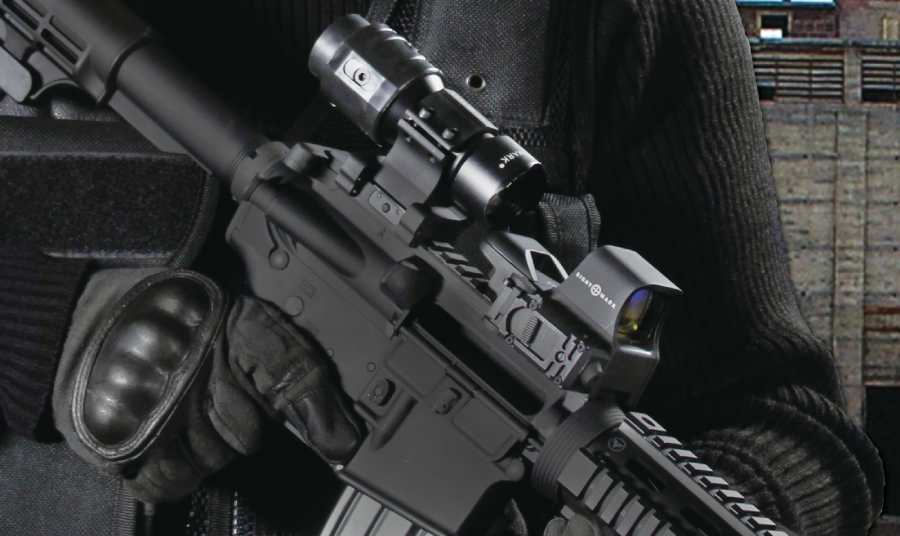With terms like "red dot," "reflex sight," and "infinite eye relief" being tossed around, it's easy to get lost in the jargon of shooting, especially for a new shooter. To help clear up the confusion, we’ve put together a guide to help you with the basics of red dot optics, from understanding their purpose to finding the perfect mounting position. Whether you’re gearing up for your first trip to the range or looking to upgrade your setup, this conversation is designed to answer your burning questions and get you on target.
What Makes a Red Dot Different from a Riflescope?
A red dot optic is designed for quick target acquisition at shorter distances, typically within 100 yards, although it’s not unheard of to use red dots to shoot targets at greater distances. Soldiers in the United States Army, for example, shoot targets as far as 300 yards away with their “Close Combat Optic” red dots. Unlike riflescopes, which offer magnification to help you see and aim at distant targets, red dots provide a clear aiming point without magnification. This makes them ideal for situations where you need to react quickly, like in home defense, tactical scenarios, or even hunting in dense environments where targets can appear suddenly and close by.
Red Dot vs Reflex Sight: What’s the Difference?
They’re similar, but there’s a subtle difference. “Red dot” is a broad term that covers any optic with a red (or sometimes green) aiming point. Reflex sights are a type of red dot optic where the reticle is reflected onto a lens and appears as a floating dot. Other types of red dots include holographic sights, where the reticle is projected as a hologram, and tritium sights, which are powered by the radioactive decay of their namesake isotope. So, while all reflex sights are red dots, not all red dots are reflex sights.

Sightmark's MTS Mini Solar.
Where Should I Mount My Red Dot Sight?
Yes, it matters, but it’s more flexible than with traditional scopes. Red dots have what’s called “infinite eye relief,” which means you can place them anywhere along the rail, and the reticle will still be clear and usable. For most people, mounting the red dot a little forward on the receiver, close to where the handguard begins, provides a good balance between field of view and ease of use. This position allows you to quickly acquire the target while keeping both eyes open, which enhances situational awareness. Those who mount the dot closer to their faces have near-immediate reticle acquisition but sacrifice their peripheral vision to do so. Contrary to popular belief, if you mount your red dot closer to your eye, you will not increase the size of the reticle.
What Is “Infinite Eye Relief” and Why Does It Matter?
Infinite eye relief means you can see the reticle clearly no matter how close or far your eye is from the optic. This is a major advantage of red dots over traditional scopes, which have a specific eye relief distance where the image is clear. With a red dot, you can mount it wherever it feels comfortable and natural for you, without worrying about finding a “sweet spot.”

Sightmark's Volta Solar. Photo credit: Jacky Rankin
What Is an Offset Red Dot Mount?
Mounting a red dot offset usually refers to placing it at a 45-degree angle on the side of your rifle. This setup is popular with shooters who use magnified scopes as their primary optic but want the option to quickly transition to a red dot for close-range shots. By tilting the rifle slightly, you can switch from the scope to the red dot in a split second simply by rotating your firearm, without adjusting your shooting position. It’s a handy technique in dynamic shooting scenarios, like competitive shooting or certain tactical applications.
Why Mount a Red Dot on Top of a Scope?
Mounting a red dot on top of a scope is another way to achieve quick transitions between long-range and short-range targets. When you need the magnification of your scope, you use it as normal. But if a target suddenly appears at close range, you can quickly shift your eye to the red dot mounted above. This setup is less common than the offset mount but can be useful in certain situations, especially on rifles with limited rail space.
What Is a Red Dot’s Recoil Rating?
Recoil rating refers to the amount of force the red dot can withstand without losing zero or getting damaged. It’s important because not all calibers produce the same amount of recoil. For instance, a .45 ACP handgun has more recoil than a 5.56mm rifle due to the violence of a handgun’s slide reciprocation. However, if a red dot is rated to handle the recoil of a .45 ACP, it’ll work just fine on a 5.56 or even a .308 Winchester rifle. The key is to ensure your optic can handle the recoil of the firearm it’s mounted on, so you can trust it to perform reliably.
Final Thoughts for New Red Dot Users
Understanding the nuances of where and how to mount your red dot can make all the difference in your shooting experience. From the flexibility of infinite eye relief to the practical benefits of offset mounting, there’s a lot to consider—but ultimately, it’s about what works best for you. Keep experimenting with different setups, and don’t hesitate to reach out to more experienced shooters or firearms experts for advice. With the right knowledge and a bit of practice, you’ll be hitting your targets with speed and precision in no time.
Have a great outdoor adventure story? Share it with us! Accepted stories will receive a 20% discount code.
Frequently Asked Questions
What Makes a Red Dot Different from a Riflescope?
A red dot optic is designed for quick target acquisition at shorter distances without magnification, typically within 100 yards, making it ideal for situations where you need to react quickly.
Red Dot vs Reflex Sight: What’s the Difference?
While all reflex sights are red dots, not all red dots are reflex sights. Reflex sights have the reticle reflected onto a lens and appear as a floating dot, whereas other types of red dots include holographic sights and tritium sights.
Where Should I Mount My Red Dot Sight?
Mounting your red dot sight a little forward on the receiver, close to where the handguard begins, provides a good balance between field of view and ease of use. This position allows for quick target acquisition while keeping both eyes open.
What Is “Infinite Eye Relief” and Why Does It Matter?
Infinite eye relief means you can see the reticle clearly no matter how close or far your eye is from the optic. This is a major advantage of red dots over traditional scopes, which have a specific eye relief distance where the image is clear.




